*This post documents my first k3s build of my minilab. In 2023, I rebuilt the cluster by introducing an intel-based master/worker node and using Cilium as my CNI. You can see this post: [[Kubernetes Cluster on Raspberry Pi using Ubuntu 22.04 LTS, K3s, and Cilium!]]
Building a Kubernetes cluster on Raspberry Pi is a great way to get started with Kubernetes and K3s is a great choice for a Lightweight Kubernetes for the Pi. The post documents my experience through the process of setting up a k3s cluster on Raspberry Pi using Ubuntu 22.04.
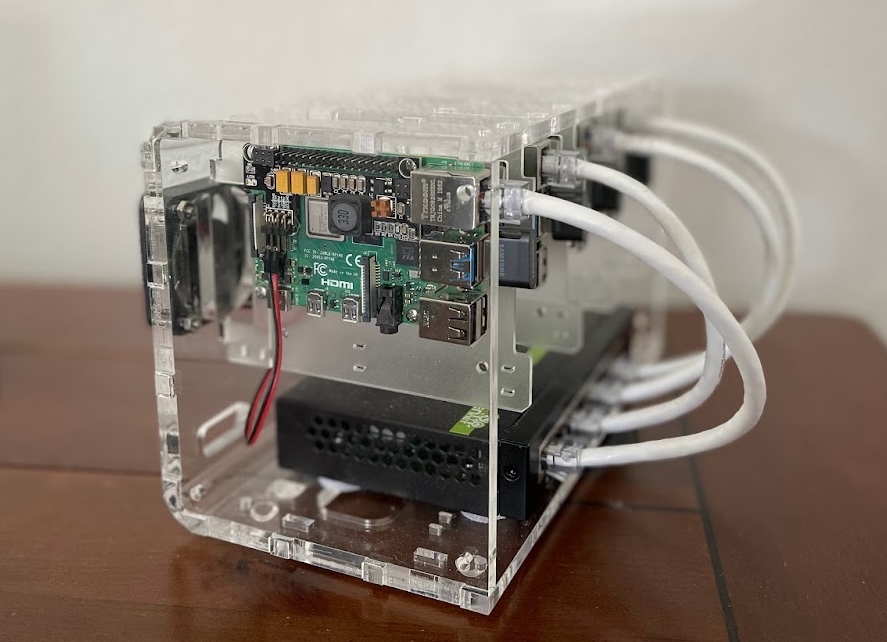
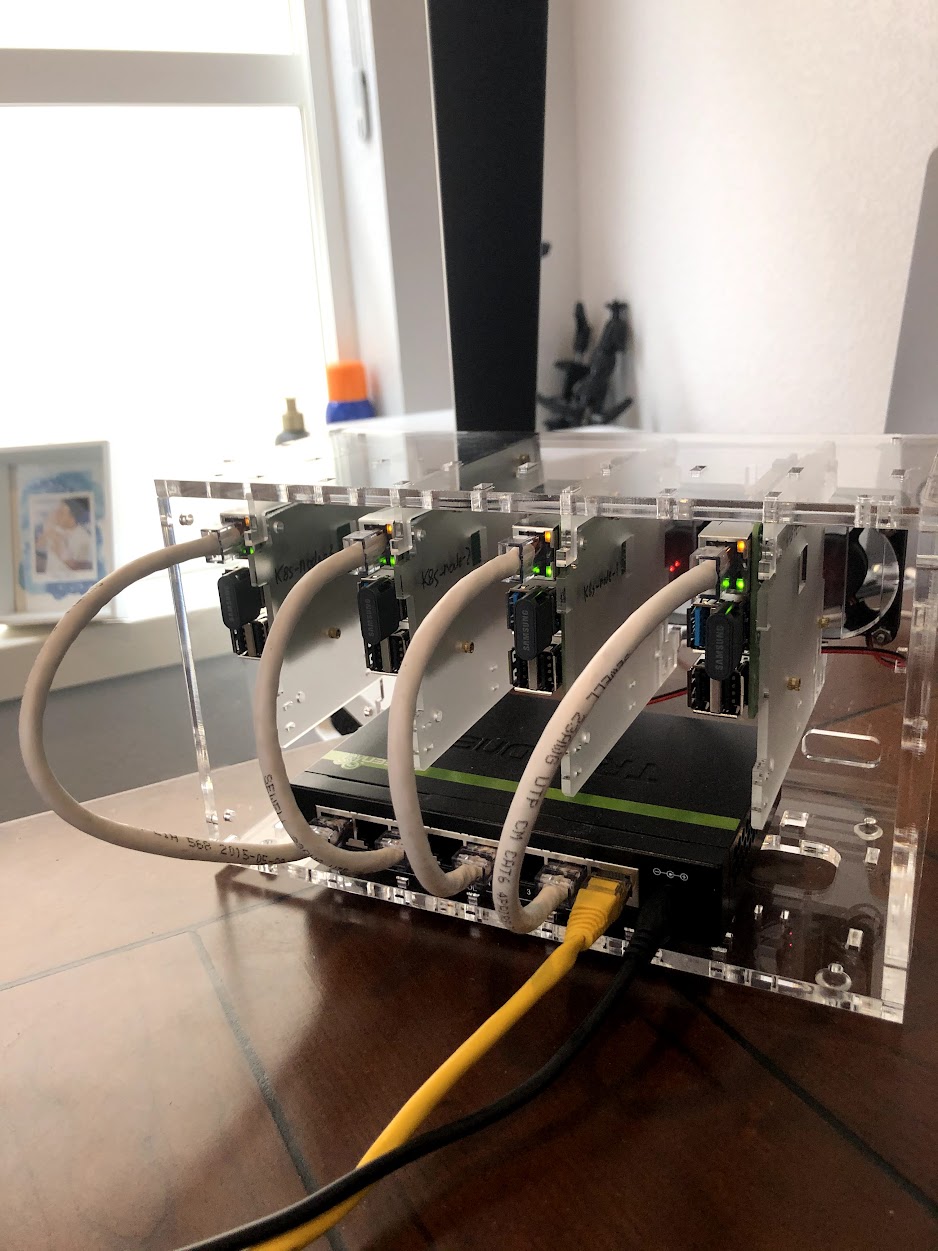
Introduction
Why Raspberry Pi?
The Raspberry Pi is a Single-Board Computer (SBC) that was originally designed as an educational tool to help people learn how to code, but it has since become very popular in the hardware and hacking communities, with people using the device for hardware projects, home automation, robotics, and other applications.
For me, it just seems like a fun way to learn Kubernetes and an excuse to tinker with physical computers again
Why Ubuntu?
Ubuntu is a popular Linux distribution on PCs, and it is available as a pre-built release for the Raspberry Pi.
The most important reason I am using Ubuntu for this project is my experience with the Linux distribution. cloud-init is a significant benefit since we can establish the initial setup (creating SSH keys for the default user, as well as installing necessary software) without requiring additional monitors or laborious manual processes.
The OS is not the most important piece of this project, you should use whatever Linux distribution you prefer on the Raspberry PI.
At the time of writing, Ubuntu 22.04 is the latest LTS release of Ubuntu. Find out the release date and the release schedule, find out what’s new in this release, and more.
Why K3s?
Initially, I had to set up “Kubernetes the hard way” on a Raspberry PI, and it was an excellent opportunity to prepare for my CKA. However, I ran into difficulties with my Raspberry PI’s OS wiping itself off cheap microSDs (which I threw away) and it was a pain going through all of the manual steps to re-deploy my Kubernetes cluster.
K3s is a lightweight “stripped-down” version of the Kubernetes Distribution, which is compatible and suitable for Raspberry Pi hardware because it is quick to install. In fact, K3s have been designed to work on ARM systems. Its simplicity makes it a breeze to install/remove/re-install when things go wrong.
Hardware Requirements
We need a few Raspberry Pi Single-Board Computers to construct our Raspberry PI Kubernetes cluster. I paid $75 for each Raspberry Pi 4 Model B (8GB memory) in 2020. With more or fewer instances, you may create a smaller or larger Kubernetes cluster.
Generally, We need
- Raspberry PIs: Obviously, any computer would do, but Raspberry PIs make for a cheap (?) and fun project. I would suggest starting with at least two so that your programs may continue to function if one node fails. In my situation, I’m utilizing a Raspberry Pi 4 (4GB) with 8GB RAM, which has greater “horsepower” than previous models.
- Power: Depending on the board, you’ll need a power supply, or a Raspberry Pi 4 requires a 5V 3A USB C/Type-C Power Supply Adapter, which shouldn’t cost more than $10. However, I am using Raspberry Pi PoE+ HAT modules and a switch with POE to power the devices.
- Micro-SD card: In order to run the operating system on each board, we’ll need a Micro-SD card of at least 16GB, and these are available for as low as $5 per piece, however, I recommend spending a little more on reputable options to save you the headache of malfunctioning and slow cards. I opted for the SanDisk Extreme Pro and went for the 64GB capacity for more storage flexibility.
- Optional - A Portable Hard Drive, USB thumb drives: Because the Kubernetes Cluster will run applications (containers) on any of our hosts, we must establish a shared drive between them. I took this opportunity to experiment with GlusterFS replicated storage and NFS share, and so I got a USB3 thumb drive per Raspberry PI.
- Ethernet Cables: Because our host machines need access to a network and the Internet. I recommend using Ethernet rather than WIFI. In my case, I’m powering my Raspberry PIs with POE anyway, and so I make sure my ethernet cables can support that.
- Ethernet Switch (optional): Small form routers typically have four to eight Ethernet ports, so you won’t need to use them all, but if you want to add or expand your network with additional equipment, eight ports is a good number.. A POE capably Ethernet switch like this one can cost around $80
- Case with cooling fan (recommended): Finally, cooling fans and heatsinks are also highly recommended to keep the CPU cool and reduce the risk of hardware failure due to overheating. I am using this case
I used the following building components (at prices in 2020):
- 4 x Raspberry Pi 4 Model B/8GB @ $75.00 USD each for a total of $300.00 USD
- 4 x Raspberry Pi PoE+ HAT @ $20.00 USD each for a total of $80 USD
- 1 X 8-Port GREENnet Gigabit PoE+ Switch for $80 USD
- 8 Slot Cluster Cloudlet for Raspberry Pi 4B for $65 USD
- 4 x SanDisk Extreme Pro 64GB Micro Memory Card for $20 USD = $80USD
- Optional (GlusterFS): SAMSUNG FIT Plus 128GB - 400 MB/s USB 3.1 Flash Drive for $20 USD = $80USD
- A few short ethernet cables I already had
-
For my NFS I had a spare external Hard drive available
Total = $685
All my components were purchased from Pi Shop Amazon and ebay
Operating System Setup
We must first set up and configure the Ubuntu Linux Operating System on each node of the future Kubernetes cluster.
Our cluster will include four machines (I mean the same thing when I saw a Raspberry PI device, a machine, a node, or a host) with each computer having its own name and IP address
- k8s0 - Master Node (
10.0.0.190) - k8s1 - Worker Node (
10.0.0.191) - k8s2 - Worker Node (
10.0.0.192) - k8s3 - Worker Node (
10.0.0.193)
The Master Node is the cluster’s primary node, in charge of orchestration. Although it is uncommon in a multi-node cluster, the Master Node may also function as a worker and execute apps if required.
A Worker node is dedicated to running our applications. It is controlled by the master node from a distance. Our worker node is a computer dedicated to running applications only. It is remotely managed by the master node.
This is my setup:
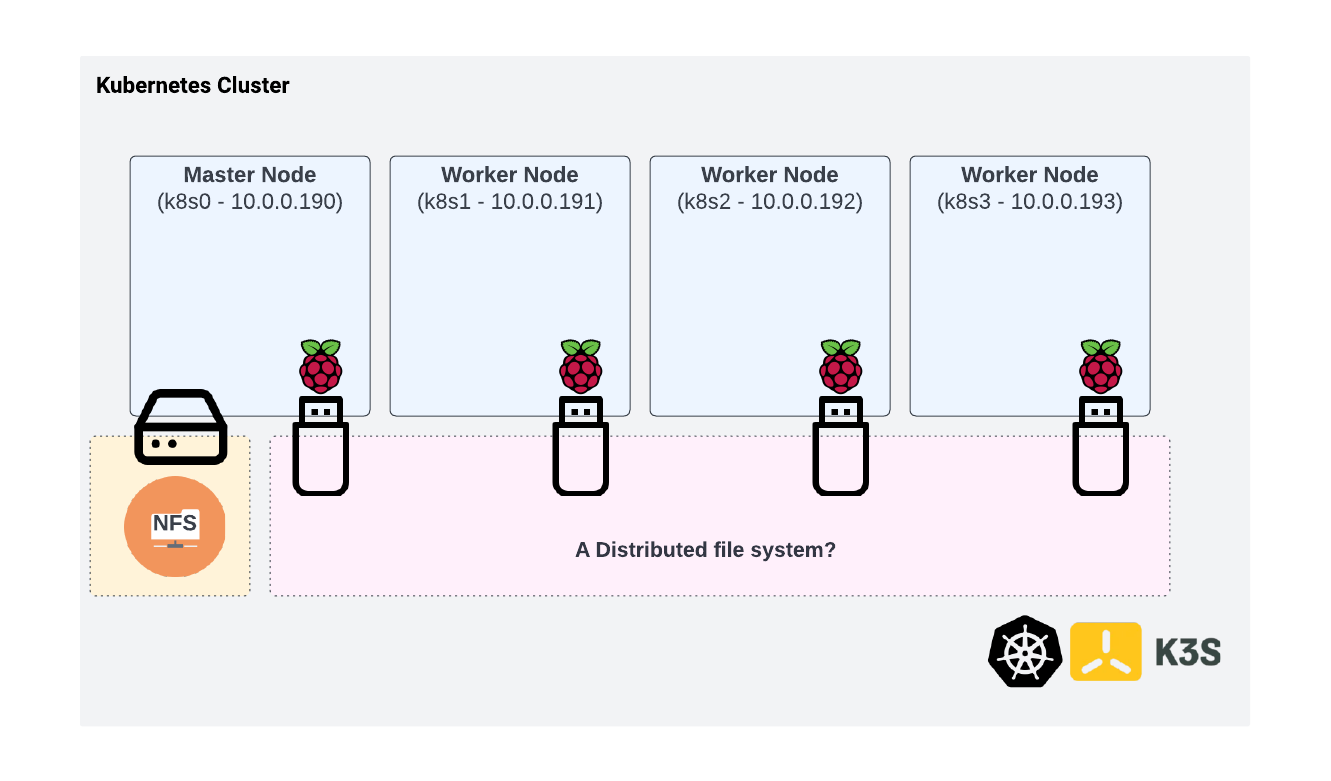
Im not sure what Distributed file system is supported or works best with K3s on Raspberry PI. Perhaps GlusterFS? or Ceph? We will leave that problem for another day.
Onwards we go…
Flash Ubuntu OS onto the Micro SD cards
I’m running Ubuntu Server 22.04 LTS 64bit. This version does not include a Desktop or Recommended package. Using this edition, we may begin with a completely clean, light, and fresh installation.
Raspberry Pi Imager is the easiest way to Install Raspberry Pi OS onto your SD card and you can download and install the Target Ubuntu OS from the tool
-
Open Raspberry PI imager > Other General Purpose OS > Ubuntu > Ubuntu Server 22.04 LTS - make sure to select 64bit
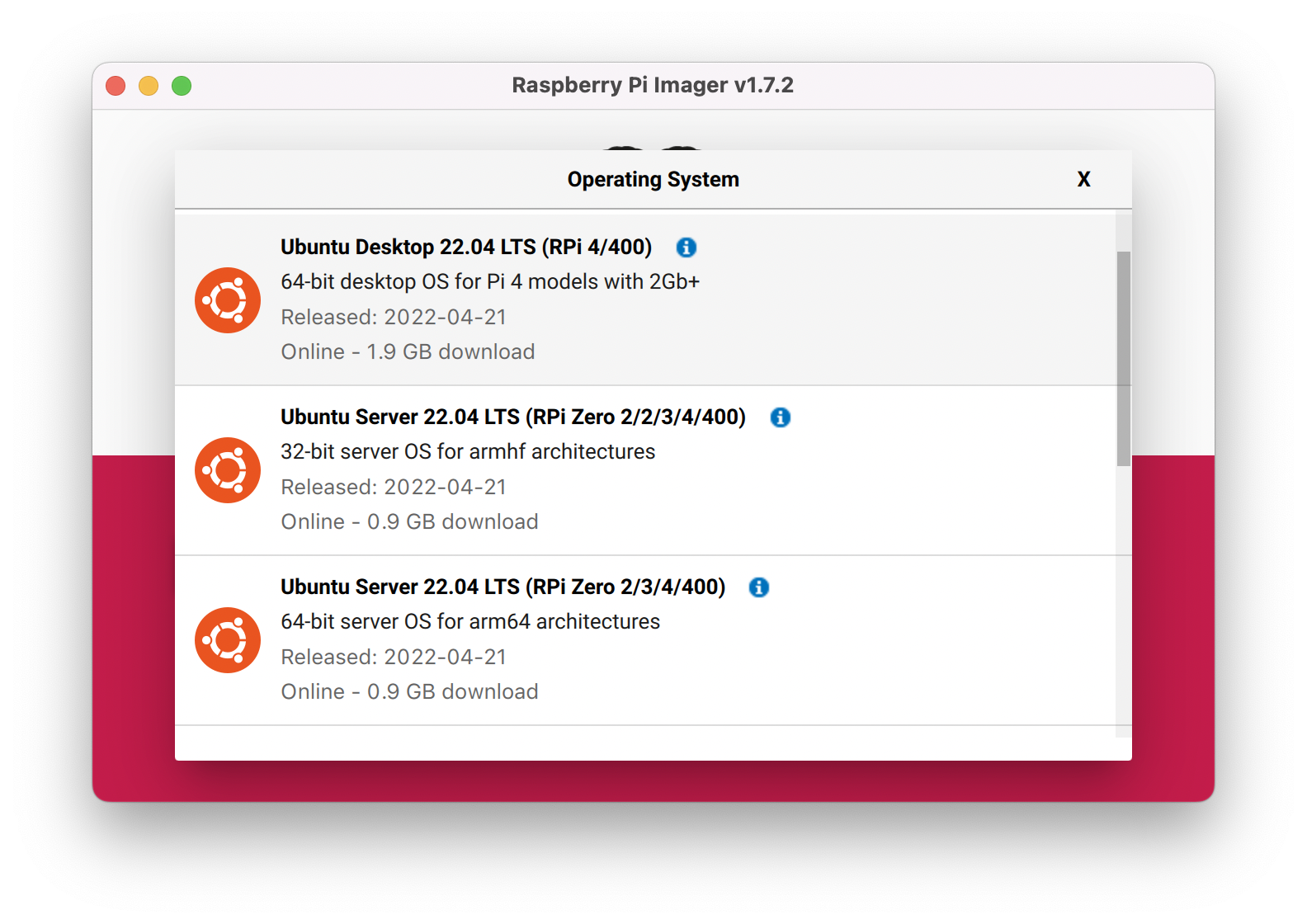
-
Plug a Micro SD Card into your local machine
-
Select the target Micro SD and ‘WRITE’
Configuring your instance during boot
Once the SD Cards are flashed with the Ubuntu, re-mount the SD Card if necessary (eject and re-insert to your machine), open the SD card with your file manager, and edit the two files user-data and cmdline.txt to set an initial configuration to the raspberry pi systems with a static IP address, hostname, and install some prerequisites software.
As a reference or template to edit from, here are two files used:
user-data, andcmdline.txt
Edit cmdline.txt
-
Inspect the
cmdline.txtfile. There likely won’t be anything required to be modified here. note that the Kubernetes install prerequisites have already been appended to the boot command line:cgroup_enable=cpuset cgroup_enable=memory cgroup_memory=1Check out my
cmdline.txtas an example
Add user-data user specific configurations (consistent on all nodes)
Edit the user-data file for your _user specific configurations (consistent on all nodes)
If you are not familiar with this file, feel free to inspect and use my user-data file as a template to edit from. Take a look at the file and comments, here are some user specific configurations in my example:
- Change the following to your needs
Feel free to add your own parameters to build your own setup.
user-data node specific configurations (unique per machine)
Futher edit the user-data for your _node-specific configurations (specific machine nodes)
-
For each node, change the node specific details -
hostnameandfqdn:hostname: k8s0 fqdn: k8s0.your-network.com.com -
For each node, change the node specific details of network interface configurations, i.e static IP Address(es)
IMPORTANT: Known Issue: Kubelet in Kubernetes supports no more than three DNS server entries in /etc/resolv.conf on each node in the cluster.
```yaml
- path: /etc/netplan/50-cloud-init.yaml # Set Static IP
permissions: '0644'
content: |
network:
version: 2
ethernets:
eth0:
dhcp4: no
addresses:
- 10.0.0.191/24
routes:
- to: default
via: 172.16.222.1
nameservers:
search: [your-network.com]
addresses: [10.0.0.2, 1.1.1.1, 8.8.8.8]
```
-
For each node, change the hostfile entries in the hosts file. i.e. hostname and static IP Address assignment
- path: /etc/hosts # Hosts files content: | 127.0.0.1 localhost k8s1 k8s1.your-network.com k8s-1 k8s-1.your-network.com ::1 localhost 10.0.0.2 dns dns.your-network.com 10.0.0.190 k8s0 k8s0.your-network.com 10.0.0.191 k8s1 k8s1.your-network.com 10.0.0.192 k8s2 k8s2.your-network.com 10.0.0.193 k8s3 k8s3.your-network.com
Cloud-init lets you do a lot. You may set up network configurations, ssh keys, and public keys for immediate SSH remote access, go the extra mile of setting up Kubernetes and k3s prerequisites or even completely build out your system from scratch. Refer to the online documentation for details on all options.
In my setup (user-data), I added a few tools for convenience and some cosmetic items like MOTD. Most importantly, though, is enabling SSH access so we avoid plugging in a monitor and keyboard to configure each node. Adding a non-root admin user with sudo access is also recommended. I’ll perform the other configurations manually for documentation purposes, like installing k3s and other Kubernetes tools.
Fire up the Raspberry PIs and connect via SSH
We’ll try to connect from our local computer to the node via SSH after each device has been powered up. If you’re using Linux, MacOS, or a similar system, all you have to do is open a new terminal. Windows users can use Putty as an SSH client if they download and install it.
The following steps need to be done on each Raspberry PI node. Using a tool like TMUX and its ## Synchronize Panes feature makes this process very easy to do in one go. This magical tool is not covered here, but you can learn more about it here.
In the last step, we had set the default user (“ubuntu”) password, a static IP address, unique Hostname, and static entries in the host files. We now assume we can access and each Node via ssh can communicate with each other via hostname resolution, therefore we can skip these basic network and user configurations
Note: If you opt to use DHCP, Your router will assign an arbitrary IP address when a device tries to join the network. To find the address attributed to the device, you can check either on your router admin panel or via a tool like netstat or angryIP
Install linux-modules-extra-raspi extra package
Through lots of frustration, I discovered Ubuntu installations were missing a kernel module that always resulted in STATUS: NotReady when my Kubernetes K3S was installed. Only by installing this kernel module was I able to finally get my Ubuntu Raspberry Pi modules to a STATUS: Ready state. Evidently, this only affects the Rasberry Pi install of Ubuntu.
On each Raspberry PI Install the linux-modules-extra-raspi extra package, a specific requirement for Ubuntu 21.10+ and k3s on Raspberry Pis
-
Run the following to install the module.
sudo apt install linux-modules-extra-raspi sudo reboot -
A reboot is required to take effect:
sudo reboot
After the reboot, we will be good to go to install K3s
Setup the Master k3s Node
The Master node’s (k8s0) initial k3s installation will serve as the control plane for our Kubernetes Cluster. I disabled the load balancer service Klipper and Traefik ingress and balancer in my install because I prefer the option to use non-bundled solutions such as MetalLB and NGINX ingress, which, in my opinion, provide more features.
-
Install
K3swith the flags to make sure/etc/rancher/k3s/k3s.yamlis world-readable and service loadBalancer,Klipper, andtraefikare disabledexport K3S_KUBECONFIG_MODE="644" export INSTALL_K3S_EXEC=" --disable servicelb --disable traefik" curl -sfL https://get.k3s.io | sh - [INFO] Finding release for channel stable [INFO] Using v1.23.6+k3s1 as release [INFO] Downloading hash https://github.com/k3s-io/k3s/releases/download/v1.23.6+k3s1/sha256sum-amd64.txt [INFO] Downloading binary https://github.com/k3s-io/k3s/releases/download/v1.23.6+k3s1/k3s [INFO] Verifying binary download [INFO] Installing k3s to /usr/local/bin/k3s [INFO] Skipping installation of SELinux RPM [INFO] Skipping /usr/local/bin/kubectl symlink to k3s, already exists [INFO] Creating /usr/local/bin/crictl symlink to k3s [INFO] Skipping /usr/local/bin/ctr symlink to k3s, command exists in PATH at /usr/bin/ctr [INFO] Creating killall script /usr/local/bin/k3s-killall.sh [INFO] Creating uninstall script /usr/local/bin/k3s-uninstall.sh [INFO] env: Creating environment file /etc/systemd/system/k3s.service.env [INFO] systemd: Creating service file /etc/systemd/system/k3s.service [INFO] systemd: Enabling k3s unit Created symlink /etc/systemd/system/multi-user.target.wants/k3s.service → /etc/systemd/system/k3s.service. [INFO] systemd: Starting k3s -
Check if the
k3sservice installed successfully,:systemctl status k3s ● k3s.service - Lightweight Kubernetes Loaded: loaded (/etc/systemd/system/k3s.service; enabled; vendor preset: enabled) Active: active (running) since Tue 2022-05-24 10:48:12 MDT; 36s ago Docs: https://k3s.io Process: 1979 ExecStartPre=/bin/sh -xc ! /usr/bin/systemctl is-enabled --quiet nm-cloud-setup.service (code=exited, status=0/SUCCESS) Process: 1981 ExecStartPre=/sbin/modprobe br_netfilter (code=exited, status=0/SUCCESS) Process: 1982 ExecStartPre=/sbin/modprobe overlay (code=exited, status=0/SUCCESS) Main PID: 1983 (k3s-server) Tasks: 88 Memory: 803.5M CPU: 55.037s CGroup: /system.slice/k3s.service ├─1983 /usr/local/bin/k3s server ├─2004 containerd -c /var/lib/rancher/k3s/agent/etc/containerd/config.toml -a /run/k3s/containerd/containerd.sock --state /run/k3s/containerd --root /var/lib/rancher/k3s/agent> ├─2588 /var/lib/rancher/k3s/data/8c2b0191f6e36ec6f3cb68e2302fcc4be850c6db31ec5f8a74e4b3be403101d8/bin/containerd-shim-runc-v2 -namespace k8s.io -id 1a9d266ca9f4ce8e62b49294ce5> ├─2613 /var/lib/rancher/k3s/data/8c2b0191f6e36ec6f3cb68e2302fcc4be850c6db31ec5f8a74e4b3be403101d8/bin/containerd-shim-runc-v2 -namespace k8s.io -id 7ede00e8f0dc750dc8c92ae15ea> └─2643 /var/lib/rancher/k3s/data/8c2b0191f6e36ec6f3cb68e2302fcc4be850c6db31ec5f8a74e4b3be403101d8/bin/containerd-shim-runc-v2 -namespace k8s.io -id 8a589604b9b0183db0d109d1e44> -
You can check if the master node is working. At this point, there is only one Master node
k3s kubectl get node NAME STATUS ROLES AGE VERSION k8s0 Ready control-plane,master 75s v1.23.6+k3s1
Connect to your K3s Kubernetes Config on the Master node
In order to manage the Kubernetes cluster you have to let kubectl know where to find the kubeconfig. You can do this by either specifying the kubeconfig file as an environment variable or copying it to the default path at ~/.kube/config. Here we do the latter
-
Copy
k3s.yamlto~/.kube/configcp /etc/rancher/k3s/k3s.yaml ~/.kube/config kubectl get nodes -
k3salso installed the Kubernetes Command Line Tools, so it is now possible to start querying the cluster usingkubectlas it looks for the Kubernetes config at~/.kube/configby defaultkubectl get nodes NAME STATUS ROLES AGE VERSION k8s0 Ready control-plane,master 3m50s v1.23.6+k3s1
If Applicable: Allow ports on the firewall
If you have a firewall (ufw) enabled we need to enable ports for worker nodes to communicate over
-
Enable ports on
ufw# We need to allow ports that will will be used to communicate between the master and the worker nodes. The ports are 443 and 6443. sudo ufw allow 6443/tcp sudo ufw allow 443/tcp
Prepare token for adding working nodes
You need to extract the K3S_TOKEN from the Master node that will be used to join the Worker nodes to the Master Node.
-
On the Master node, make a node of the
k3sjoin tokensudo cat /var/lib/rancher/k3s/server/node-tokenYou will then obtain a token that looks like:
K103cc1634360ddec824fd7afa3beea11c4e733fe6f642752ec928419bf949f29bb::server:cbba8f488b3ab6dcb61438f8d48c43a9
Install k3s on Worker nodes and connect them to the Master Node
The next step is to install k3s on the Kubernetes Worker nodes (k8s1, k8s2 and k8s3). We will install k3s while providing the join token. Remember to replace the Master node IP address and token with your specific deployment
-
Set variables for
K3S_URLandK3S_TOKENand run thek3sinstallation script# curl -sfL https://get.k3s.io | K3S_URL=https://<master_IP>:6443 K3S_TOKEN=<join_token> sh -s export K3S_KUBECONFIG_MODE="644" export K3S_URL="https://10.0.0.190:6443" export K3S_TOKEN="K103cc1634360ddec824fd7....f642752ec928419bf949f29bb::server:cbba...." curl -sfL https://get.k3s.io | sh - -
We can verify if the
k3s-agenton the Worker nodes is running by:sudo systemctl status k3s-agent -
If the service failed to start, you may need to restart and check again:
sudo systemctl restart k3s-agent sudo systemctl status k3s-agent ● k3s-agent.service - Lightweight Kubernetes Loaded: loaded (/etc/systemd/system/k3s-agent.service; enabled; vendor preset: enabled) Active: active (running) since Tue 2022-05-24 11:59:49 CDT; 465ms ago Docs: https://k3s.io Process: 4620 ExecStartPre=/bin/sh -xc ! /usr/bin/systemctl is-enabled --quiet nm-cloud-se> Process: 4622 ExecStartPre=/sbin/modprobe br_netfilter (code=exited, status=0/SUCCESS) Process: 4623 ExecStartPre=/sbin/modprobe overlay (code=exited, status=0/SUCCESS) Main PID: 4624 (k3s-agent) Tasks: 8 Memory: 18.5M CPU: 829ms CGroup: /system.slice/k3s-agent.service └─4624 "/usr/local/bin/k3s " "" "" "" "" "" May 24 11:59:49 k8s2 systemd[1]: Starting Lightweight Kubernetes... May 24 11:59:49 k8s2 sh[4620]: + /usr/bin/systemctl is-enabled --quiet nm-cloud-setup.service May 24 11:59:49 k8s2 sh[4621]: Failed to get unit file state for nm-cloud-setup.service: No su> May 24 11:59:49 k8s2 systemd[1]: Started Lightweight Kubernetes. -
To verify that our Worker nodes have successfully been added to the
k3scluster, run thiskubectlcommand back on the Master Node wherekubectlhas been installed:kubectl get nodes -o wide # or k3s kubectl get nodes -o wide NAME STATUS ROLES AGE VERSION INTERNAL-IP EXTERNAL-IP OS-IMAGE KERNEL-VERSION CONTAINER-RUNTIME k8s0 Ready control-plane,master 35m v1.23.6+k3s1 10.0.0.190 <none> Ubuntu 22.04 LTS 5.15.0-1008-raspi containerd://1.5.11-k3s2 k8s3 Ready <none> 26m v1.23.6+k3s1 10.0.0.193 <none> Ubuntu 22.04 LTS 5.15.0-1008-raspi containerd://1.5.11-k3s2 k8s2 Ready <none> 26m v1.23.6+k3s1 10.0.0.192 <none> Ubuntu 22.04 LTS 5.15.0-1008-raspi containerd://1.5.11-k3s2 k8s1 Ready <none> 26m v1.23.6+k3s1 10.0.0.191 <none> Ubuntu 22.04 LTS 5.15.0-1008-raspi containerd://1.5.11-k3s2
Connect remotely to the k3s cluster from your local machine
Using kubectl we can manage our Kubernetes cluster remotely from a our local machine. If you have not done so already, make sure you have installed kubetl by following the instructions on the Kubernetes documentation, e.g. Install kubectl binary with curl on Linux
The following steps now assume you have Installed kubectl on your local machine and are managing other Kubernetes clusters, so we will merge and add the new cluster to the local config (e.g. ~./kube/config)
By default, the k3s cluster is called “default” and if you already have a Kubernetes cluster on your local machine named “default, we won’t be able to merge our new k3s cluster config with our existing Kubernetes configuration. While there are several approaches to resolving this, the following is one, and will delete the existing conflicting “default” cluster configuration before merging our new k3s config:
-
Add our new Kubernetes cluster config to the local machine. In this example, I replace localhost
127.0.0.1with the remote address of the master node10.0.0.190and replace my “default” cluster by first deleting the existing cluster config# Copy Kube config from master node to local machine scp [email protected]:~/.kube/config otherconfig # Replace 127.0.0.1 with external IP or Hostname sed -i '' 's/127\.0\.0\.1/10\.0\.0\.190/g' otherconfig # Backup current kube config cp ~/.kube/config ~/.kube/config_BACKUP # Delete potential conflicting "default" cluster config kubectl config delete-cluster default # Merge config konfig=$(KUBECONFIG=~/.kube/config:otherconfig kubectl config view --flatten) echo "$konfig" > ~/.kube/config -
If you get an error “
WARNING: Kubernetes configuration file is group-readable. This is insecure. Location: /Users/xxx/.kube/config”. you can set the correct permissions:chmod go-r ~/.kube/config -
Change
kubectlcluster context to k3s (“default”)# Get a list of Kubernetes clusters in your local Kube config kubectl config get-clusters NAME default do-sfo2-doks-armand-sfo2 docker-desktop arn:aws:eks:us-west-2:832984185795:cluster/eks-armand-uswest2 # Set context to our k3s cluster "default" kubectl config use-context default # Check which context you are currently targeting kubectl config current-context # Get Nodes in the target Kubernetes cluster kubectl get nodes kubectl get nodes NAME STATUS ROLES AGE VERSION k8s0 Ready control-plane,master 26h v1.23.6+k3s1 k8s1 Ready <none> 26h v1.23.6+k3s1 k8s2 Ready <none> 26h v1.23.6+k3s1 k8s3 Ready <none> 26h v1.23.6+k3s1
Install Metal LB
MetalLB is a load-balancer implementation for bare metal Kubernetes clusters. MetalLB hooks into your Kubernetes cluster and provides a load-balancing implementation. It allows you to set up Kubernetes services of type “LoadBalancer” in your own cluster like a cloud provider managed Kubernetes platform
When configuring a Kubernetes service of type LoadBalancer, MetalLB will dedicate a Virtual IP from an address pool to be used as a load balancer for an application.
This step assumes the helm is installed on your local machine. If you do not have helm installed, you can do so now by following the install instrucitons, Install Helm
To install MetalLB from Helm, we need to simply run the following command helm install. Here are the flags and values I used:
metallb: the name to give to the deploymentstable/metallb: the name of the chart--namespace kube-system: the namespace in which we want to deploy MetalLB.-
--set configInline...: to configure MetalLB in Layer 2 mode (or more details, see the documentation ). The IPs range10.0.0.230-10.10.0.250is used to constitute a pool of virtual IP addresses.# Add the Helm repo helm repo add metallb https://metallb.github.io/metallb # Install Helm with the provided options helm install metallb metallb/metallb --namespace kube-system \ --set configInline.address-pools[0].name=default \ --set configInline.address-pools[0].protocol=layer2 \ --set configInline.address-pools[0].addresses[0]=10.0.0.230-10.0.0.250
Time to test: Deploy a example application
If you have got this far without issues then we are ready to deploy our first application!
I have provided a yaml manifest here that will deploy a sample application and expose it outside of your Kubernetes cluster with metal LB.
-
Apply the
yamlmanifest usingkubectlkubectl apply -f the-moon-all-in-one.yaml -
We can see everything being created using the
watchcommand in combination withkubectlwatch kubectl get all -n solar-system -o wide NAME READY STATUS RESTARTS AGE IP NODE NOMINATED NODE READINESS GATES pod/moon-856d78f799-874lp 0/1 ContainerCreating 0 3s <none> k8s2 <none> <none> pod/moon-856d78f799-pqqb5 1/1 Running 0 3s 10.42.4.14 k8s2 <none> <none> pod/moon-856d78f799-zvc92 1/1 Running 0 3s 10.42.3.11 k8s3 <none> <none> pod/moon-856d78f799-8gbtp 1/1 Running 0 3s 10.42.1.12 k8s1 <none> <none> NAME TYPE CLUSTER-IP EXTERNAL-IP PORT(S) AGE SELECTOR service/moon-lb-svc LoadBalancer 10.43.116.33 10.0.0.230 80:31555/TCP 3s app=moon service/moon-svc ClusterIP 10.43.158.140 <none> 80/TCP 3s app=moon NAME READY UP-TO-DATE AVAILABLE AGE CONTAINERS IMAGES SELECTOR deployment.apps/moon 3/4 4 3 4s moon armsultan/solar-system:moon-nonroot app=moon NAME DESIRED CURRENT READY AGE CONTAINERS IMAGES SELECTOR replicaset.apps/moon-856d78f799 4 4 3 4s moon armsultan/solar-system:moon-nonroot app=moon,pod-template-hash=856d78f799
In the example output above, my metallb service LoadBalancer has exposed my “moon” application on the IP address 10.0.0.230
…and that my friend, is that moon.
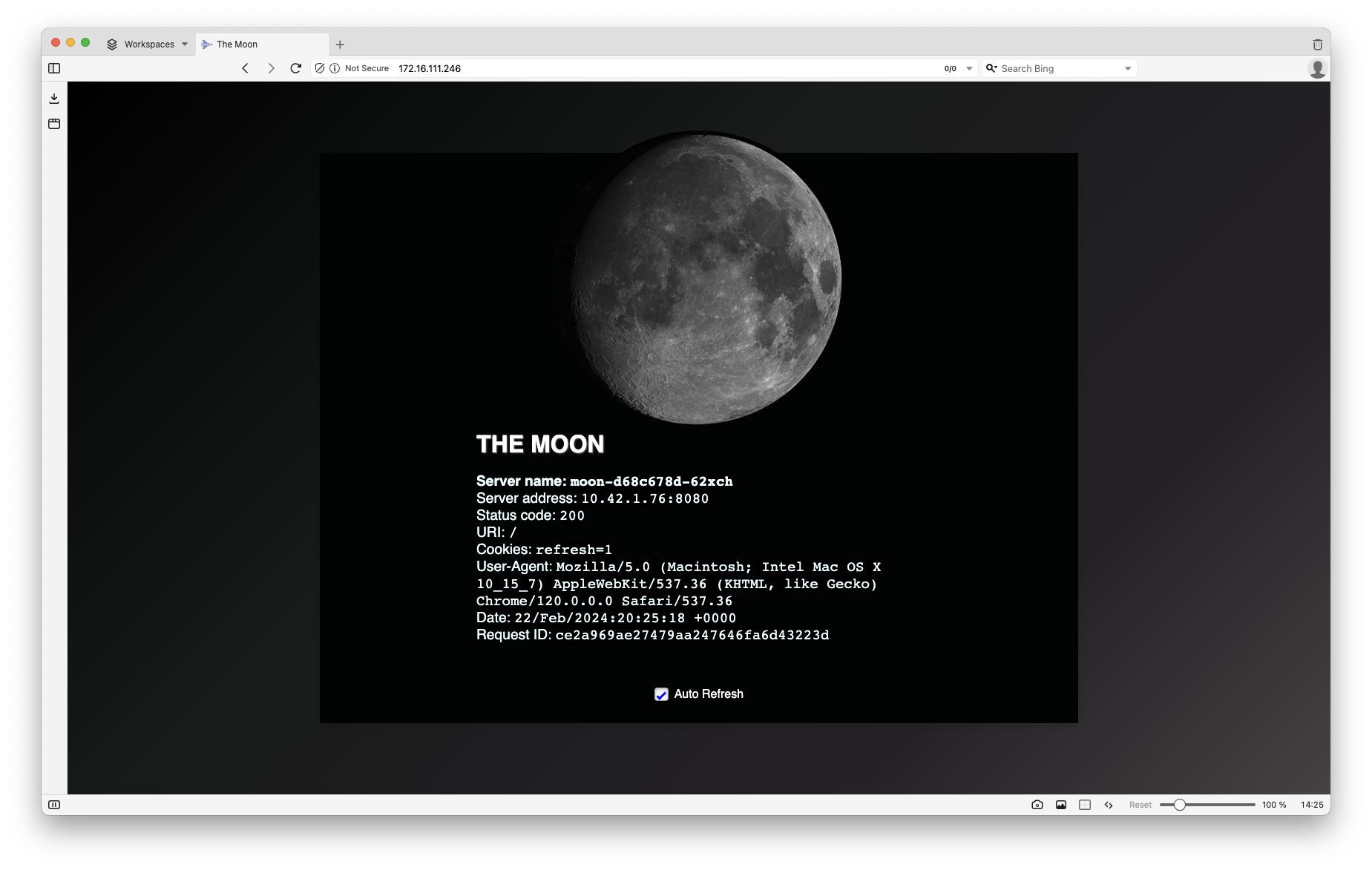
-
If you would like to delete this deployment we can simple delete everything in namespace “
solar-system”kubectl delete namespace solar-system
We have our K3s cluster up and running!
